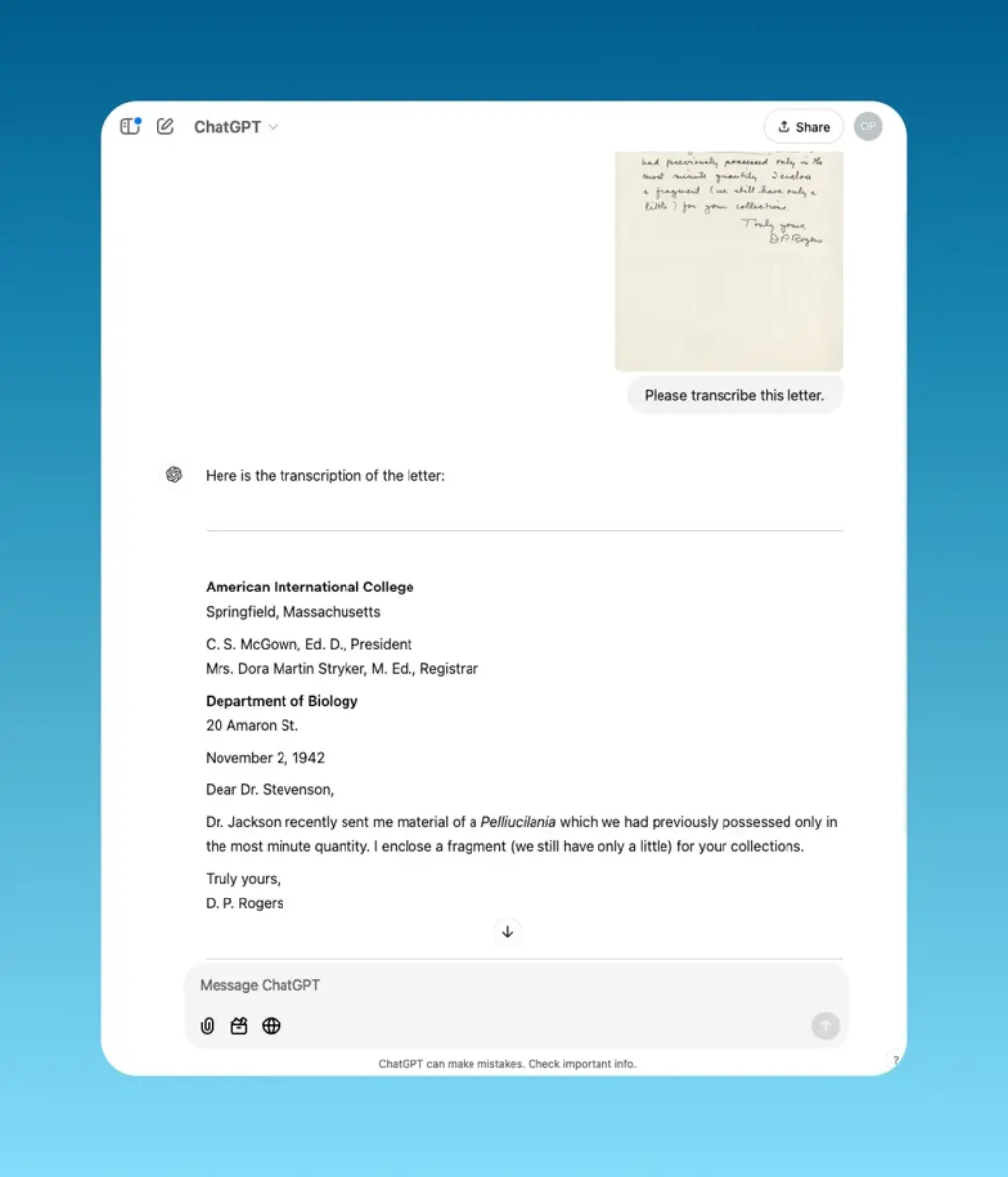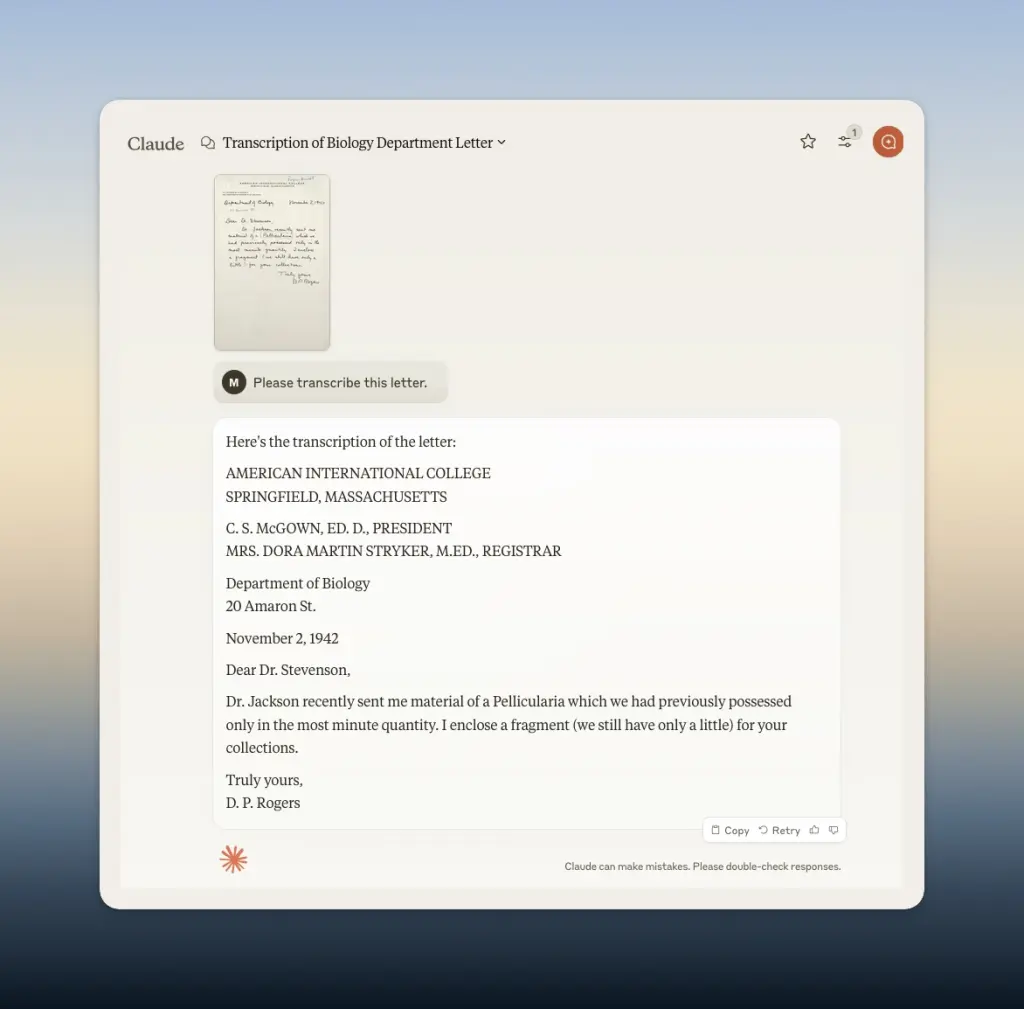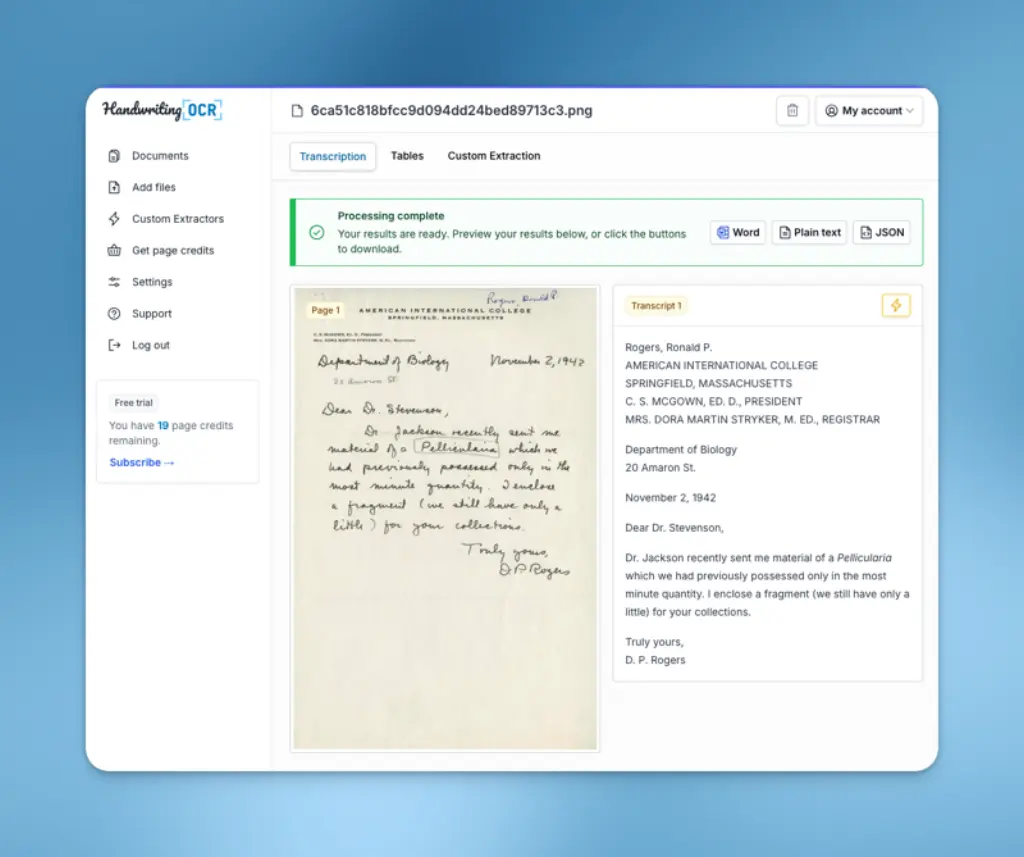ChatGPT, Claude and other AI models for OCR: pros and cons
Last updated: May 28, 2025
Picture this: boxes of old family letters in the attic, notebooks filled with meeting notes scattered across your desk, or stacks of handwritten research notes waiting to be digitized. Converting handwriting to text has always been a tedious task – until now. The world of artificial intelligence has seen remarkable advances in recent years, particularly with the emergence of Large Language Models (LLMs) like ChatGPT and Claude. These AI systems have revolutionized how we interact with computers, allowing us to have natural conversations and process information in ways that seemed impossible just a few years ago. One of their most impressive features is their ability to understand images – they can look at a photo and describe what they see, read text from signs, and even interpret complex diagrams. This visual capability has led many to wonder whether these AI models could help with everyday tasks like converting handwritten notes to text. After all, if ChatGPT can look at an image and tell you what's in it, surely it can read your handwriting, right? The answer is yes, but with some important caveats that we'll explore.
While tech giants like Google, Amazon, and OpenAI are pushing the boundaries of what AI can understand from images, specialized tools have been quietly perfecting the specific task of handwriting recognition. Tools like HandwritingOCR have focused solely on converting handwritten text to digital format, raising an interesting question: which approach serves users better?
In this comprehensive comparison, we'll put both approaches to the test. We'll examine how general-purpose AI models stack up against specialized OCR tools, looking at real-world examples, comparing accuracy rates, and helping you understand which solution might work best for your needs. Whether you're a student digitizing study notes, a professional organizing meeting minutes, or someone looking to preserve family history, this guide will help you navigate the growing landscape of handwriting recognition tools.
Let's dive in and discover the strengths and limitations of each approach, so you can make an informed decision about the best way to bring your handwritten documents into the digital age.
Understanding Modern AI Vision Tools
In late 2023 and early 2024, the AI landscape transformed dramatically with the introduction of vision capabilities to major language models. These AI systems can now "see" and understand images, opening up new possibilities for handling handwritten text. Let's look at the key players in this space:

ChatGPT (OpenAI)
Released in late 2023, GPT-4 expanded ChatGPT's capabilities to include image understanding. It can analyze photos, diagrams, and handwritten text with impressive accuracy. This and following models like GPT-4o excel at understanding context and can even help decipher messy handwriting by using contextual clues. However, it processes one image at a time and requires a ChatGPT Plus subscription ($20/month).

Claude can do a great job of handwriting to text OCR
Claude (Anthropic)
Claude's vision capabilities match and sometimes exceed GPT-4's performance. It particularly shines when handling complex document layouts and can maintain formatting better than most other LLMs. Claude shows exceptional accuracy with typed text but, like other LLMs, can struggle with particularly messy handwriting. It's available through various platforms and APIs.
Gemini (Google)
Google's Gemini brings robust vision capabilities and integrates seamlessly with Google's ecosystem. It handles multiple languages well and can process handwritten text quickly. While it sometimes struggles with cursive writing, its strength lies in handling printed handwriting and structured documents. Access comes through Google One AI Premium subscription.
Amazon Nova
Amazon's recent entry into the vision AI space offers enterprise-level capabilities. Their models excel at processing structured documents and can handle handwritten text with good accuracy. While primarily aimed at business users, these tools offer scalable solutions for large-scale document processing.
How These LLMs Work With Handwriting
When you show these AI models a handwritten note, they perform several steps:
- Visual Analysis: They scan the image to identify text areas and distinguish them from drawings or diagrams
- Character Recognition: They process individual characters and words
- Context Understanding: They use surrounding context to improve accuracy
- Natural Language Processing: They clean up and format the recognized text
Each model has its own approach, but they share common limitations:
Challenge
Impact
One-at-a-time Processing
Must upload images individually
Format Preservation
May lose original document formatting
Consistency
Results can vary between attempts
Batch Processing
Limited or non-existent
Privacy Concerns
Data may be used for model training
Hallucinations
AI may invent text that wasn't in the original
Let's examine each of these challenges in detail to understand their practical impact on your document conversion needs:
One-at-a-time Processing
The requirement to upload images individually is perhaps the most significant practical limitation of using LLMs for handwriting conversion. Imagine you have a 50-page notebook to digitize – you'll need to photograph and upload each page separately, waiting for the AI to process each one before moving to the next. This isn't just time-consuming; it can also be frustrating when dealing with lengthy documents. While some platforms offer workarounds through their APIs, these usually require technical knowledge and custom programming.
Batch Processing Limitations
The lack of proper batch processing capabilities significantly impacts efficiency when working with multiple documents. While specialized OCR tools can handle hundreds of pages in one go, LLMs require individual attention for each page. This isn't just about the time spent uploading – it's also about managing the process, keeping track of what's been converted, and ensuring nothing gets missed. For businesses or individuals with large document collections, this limitation can make LLMs impractical for serious document conversion projects.
Format Preservation
When LLMs convert handwritten text, they typically output plain text without maintaining the original document's layout. This means that if you have a structured document – like a form with specific fields, a multi-column layout, or a page with margin notes – the converted text will lose this structure. Tables might become simple text blocks, and carefully formatted notes might lose their organizational hierarchy. For many users, particularly those working with structured documents or academic materials, this loss of formatting means additional time spent reformatting the converted text.
Consistency Challenges
One particularly frustrating aspect of using LLMs for handwriting conversion is their inconsistency between attempts. You might upload the same page twice and get slightly different results each time. This happens because these models make probability-based decisions about what they're seeing, and these can vary between attempts. For critical documents where accuracy is paramount, this inconsistency means you might need to process the same page multiple times and manually compare results to ensure accuracy.
Batch Processing Limitations
The lack of proper batch processing capabilities significantly impacts efficiency when working with multiple documents. While specialized OCR tools can handle hundreds of pages in one go, LLMs require individual attention for each page. This isn't just about the time spent uploading – it's also about managing the process, keeping track of what's been converted, and ensuring nothing gets missed. For businesses or individuals with large document collections, this limitation can make LLMs impractical for serious document conversion projects.
Privacy and Data Security
Perhaps the most serious consideration when using LLMs for document conversion is privacy. Most major AI companies explicitly state that they may use uploaded content to improve their models. This means your handwritten notes, personal documents, and sensitive information could potentially become part of their training data. This poses significant problems for several use cases:
- Healthcare Records: Medical professionals cannot risk patient information being exposed to third-party AI systems
- Educational Documents: Student assignments and assessments require confidentiality under various privacy laws
- Personal Journals and Diaries: Private thoughts and personal reflections should remain private
- Business Documents: Corporate strategies, financial records, and confidential memos need to stay secure
- Legal Documents: Client communications and case notes often contain privileged information
While some providers offer enterprise solutions with stronger privacy guarantees, these are typically expensive and still require careful consideration of data handling policies. For many professional and personal use cases, the privacy implications of using LLMs make them unsuitable for document conversion.
The limitations of LLMs need to be carefully considered, but these tools aren't without their merits. Let's explore what makes them valuable for certain use cases.
Hallucinations
A significant challenge unique to LLMs is their tendency to hallucinate - generating text that wasn't present in the original document. During our testing, we observed several types of hallucinations:
- Context Completion: When part of a word is unclear, LLMs sometimes complete it based on context, which can lead to incorrect transcriptions
- Format Filling: In forms or structured documents, LLMs occasionally "filled in" blank fields with plausible but fabricated content
- Missing Text Inference: When portions of text were faded or unclear, LLMs would sometimes generate probable text rather than indicating the text was unreadable
- Language Correction: LLMs occasionally "corrected" spelling or grammar in the original text, particularly with historical documents
This behavior is particularly problematic for applications requiring high fidelity to the source material, such as legal documents or historical archives. Unlike traditional OCR tools that simply fail to recognize unclear text, LLMs might confidently provide incorrect transcriptions that can be difficult to identify without careful comparison to the original.
Key Advantages of LLMs for Document Processing
The key advantage these models offer is their flexibility – they can not only read your handwriting but also understand and analyze the content. For example, if you show them a handwritten recipe, they can not only transcribe it but also suggest modifications or answer questions about the ingredients.
However, this versatility comes at the cost of specialized accuracy. While they might achieve 80-85% accuracy on clear handwriting, their performance can drop significantly with cursive writing or poor image quality. They're also not designed for processing large volumes of documents efficiently.
The key advantage these models offer is their flexibility – they can not only read your handwriting but also understand and analyze the content. For example, if you show them a handwritten recipe, they can not only transcribe it but also suggest modifications or answer questions about the ingredients.
However, this versatility comes at the cost of specialized accuracy. While they might achieve 80-85% accuracy on clear handwriting, their performance can drop significantly with cursive writing or poor image quality. They're also not designed for processing large volumes of documents efficiently.
Specialized OCR Services: The Best of Both Worlds

Handwriting OCR offers excellent accuracy with the features needed for high-volume OCR
While LLMs offer impressive capabilities, specialized services like HandwritingOCR represent a more focused solution that combines AI technology with purpose-built features. Let's examine how a specialized service addresses the key limitations we've discussed:
Accuracy Through Specialization
Unlike general-purpose AI models that handle everything from image recognition to conversation, HandwritingOCR's models are trained specifically for handwriting recognition. This specialization typically results in significantly higher accuracy rates, particularly for:
- Cursive writing that often confuses general AI models
- Documents with mixed handwritten and printed text
- Complex layouts including tables and forms
- Historical documents with aged or faded text
Format Preservation and Export Options
A major advantage of specialized OCR services is their ability to maintain document structure and provide flexible export options. HandwritingOCR can:
- Preserve the original document layout and formatting
- Export directly to editable formats like Microsoft Word
- Convert tables to Excel spreadsheets while maintaining structure
- Generate searchable PDFs that retain the original appearance
- Support batch processing with consistent formatting
Privacy and Security
Perhaps the most significant advantage is the robust privacy guarantee. Unlike LLMs that may use uploaded content for model training, specialized OCR services like HandwritingOCR offer:
- Complete privacy guarantees
- No data retention
- Compliance with privacy regulations
- Optional on-premises deployment for sensitive documents
- Secure processing without training data collection
Batch Processing and Efficiency
While LLMs process documents one at a time, specialized services offer:
- Bulk upload capabilities
- Automated processing of multiple documents
- Consistent results across repeated scans
- Progress tracking for large projects
- API access for integration with existing workflows
Cost-Effectiveness
Though specialized services may seem more expensive initially, they often prove more cost-effective when considering:
- Higher accuracy means less manual correction
- Batch processing saves time and effort
- Preserved formatting eliminates reformatting work
- Guaranteed privacy avoids potential compliance issues
- Purpose-built features reduce overall processing time
Real-World Applications
The advantages of specialized OCR services become particularly apparent in specific use cases:
Academic Research
- Process large collections of historical documents
- Maintain precise formatting for citations
- Ensure accurate transcription of technical terms
- Export directly to research-friendly formats
Business Operations
- Convert handwritten forms to digital data
- Process customer feedback forms efficiently
- Digitize legacy business records
- Maintain compliance with data privacy regulations
Personal Archives
- Preserve family letters and documents
- Convert old journals to searchable text
- Maintain the original layout of important documents
- Keep personal writings private and secure
LLMs vs Handwriting OCR compared
Feature
Large Language Models (ChatGPT, Claude)
Specialized Handwriting OCR
Accuracy
80-85% on clear handwriting, lower on cursive
90%+ accuracy across all writing styles
Privacy
Data may be used for model training
Complete privacy guaranteed, no data retention
Processing Speed
One document at a time
Bulk processing available
Formatting
Outputs plain text, loses original layout
Preserves original formatting and structure
Export Options
Plain text only
Multiple formats (Word, Excel, Markdown, JSON)
Consistency
Results can vary between attempts
Consistent results across repeated scans
Integration
Limited API options, platform-dependent
Full API access, workflow integration
Cost Model
Monthly subscription (e.g., $20/mo for ChatGPT Plus)
Pay-per-use or enterprise licensing
Use Case Focus
General-purpose AI with OCR capability
Specialized for document processing
Additional Features
Can analyze and explain content
Focused on accurate transcription and formatting
Error Handling
May hallucinate or fill in unclear text
Flags unclear text for review
Language Support
Excellent multilingual capabilities
Excellent multilingual capabilities
Document Structure
Cannot maintain complex layouts
Preserves tables, forms, and complex layouts
Batch Processing
Manual, one-at-a-time uploads
Automated bulk processing
Learning Curve
Easy to use, conversational interface
Purpose-built interface for document processing
Safety Filters
May block processing of legitimate documents due to content restrictions
No content restrictions, processes all document types
Usage Limits
Rate limits and quotas restrict volume of work
No artificial limits on processing volume
Conclusion
While LLMs represent an exciting advancement in AI technology, their limitations in document processing highlight the value of specialized solutions. Services like HandwritingOCR offer a more complete package: combining the power of AI with purpose-built features, superior accuracy, and guaranteed privacy. For organizations and individuals serious about converting handwritten documents to digital text, these specialized services provide a more reliable, efficient, and secure solution.